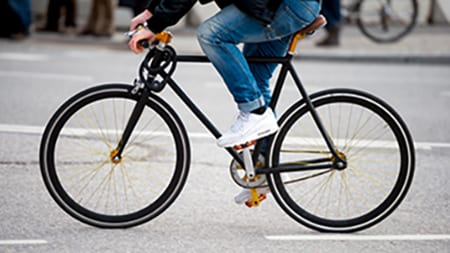Key points
- Thousands of bicyclists are injured or killed in the United States every year.
- Some groups are at higher risk for bicycle injuries and deaths.
- Injuries and deaths among bicyclists are preventable.

Facts
- Each year, nearly 1,000 bicyclists die on our nation’s roads in crashes involving a motor vehicle.1
- There are also an estimated 120,000 emergency department visits of bicyclists treated for non-fatal crash-related injuries annually.1
- Bicycle trips make up 1% of all trips in the United States.2 However, bicyclists account for 2-3% of people who die in a crash involving a motor vehicle on US roads.31
Note that bicycle refers to bicyclists and other cyclists including riders of two-wheel, nonmotorized vehicles, tricycles, and unicycles powered only by pedals. E-bicycle injuries are currently counted as motorcycle injuries: see motorcycle safety page.
Risk factors
- Most bicyclist deaths occur in urban areas.3
- About 59% of bicyclist deaths occur on sections of roads away from intersections (where higher speeds might occur) and 29% occur at intersections.3
- More than one-third of crashes that result in a bicyclist's death involve alcohol for the motor vehicle driver and/or bicyclist.3
Injuries and deaths among bicyclists are preventable
Effective interventions
Effective interventions to reduce injuries and fatalities to bicyclists include the following:
- Several roadway engineering measures, like bike lanes, can improve safety for bicyclists. Information on these proven interventions is available from the Federal Highway Administration and The Pedestrian and Bicycle Information Center.
- Bicycle helmets reduce the risk of head and brain injuries in the event of a crash.456 All bicyclists, regardless of age, can help protect themselves by wearing properly fitted bicycle helmets every time they ride.
- Bicycle helmet laws are effective for increasing helmet use and reducing crash-related injuries and deaths among children and adults.7
- Lower speed limits can increase reaction time for both drivers and cyclists resulting in fewer crashes and less severe cyclist injuries when crashes occur.7
- Safe Routes to School programs make it safer for students to walk and bike to school.7
- Centers for Disease Control and Prevention (CDC). WISQARS — Web-based Injury Statistics Query and Reporting System. U.S. Department of Health and Human Services, Centers for Disease Control and Prevention, National Center for Injury Prevention and Control; 2024.
- Federal Highway Administration. 2022 National Household Travel Survey. Washington, DC: US Department of Transportation; 2022. Available at: https://nhts.ornl.gov/person-trips.
- National Highway Traffic Safety Administration. Traffic Safety Facts, 2022 data – bicyclists and other cyclists. Washington, DC: US Department of Transportation; 2024. (Publication no. DOT HS 813 591).
- Hoye A. Bicycle helmets – to wear or not to wear? A meta-analyses of the effects of bicycle helmets on injuries. Accid Anal Prev 2018;117:85-97.
- Olivier J, Creighton P. Bicycle injuries and helmet use: a systematic review and meta-analysis. Int J Epidemiol 2017;46:278-292.
- Strotmeyer SJ, Behr C, Fabio A, Gaines BA. Bike helmets prevent pediatric head injury in serious bicycle crashes with motor vehicles. Int J Epidemiol 2020;7(Suppl 1):24.
- National Highway Traffic Safety Administration. Countermeasures that work: A highway safety countermeasures guide for State Highway Safety Offices, 11th edition [498 pages] (Report No. DOT HS 813 490). Washington, DC: National Highway Traffic Safety Administration. 2023.
